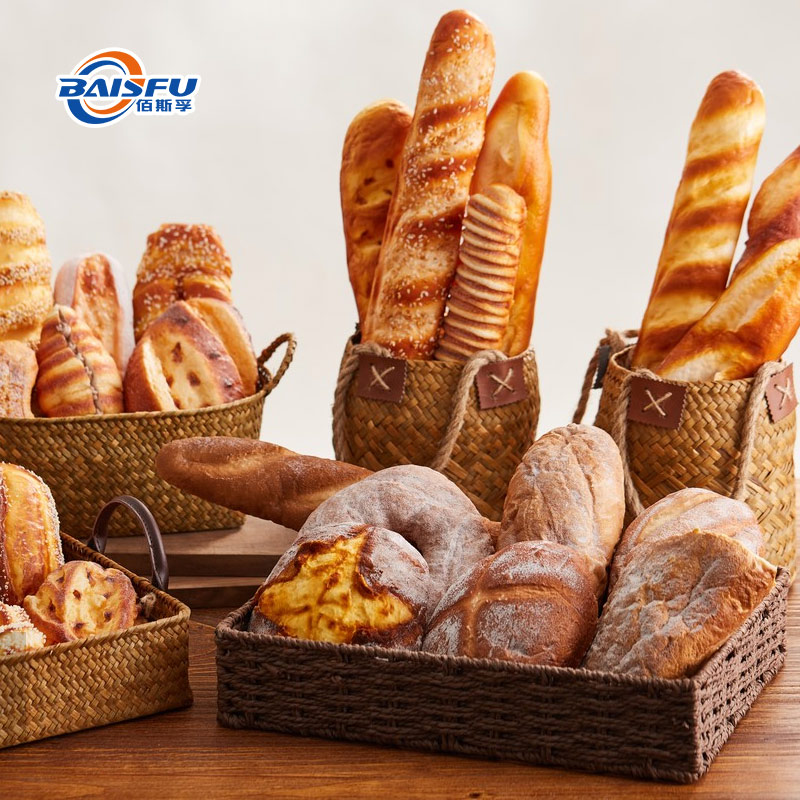A complete analysis of the application of edible flavors in baked goods

Baked goods are Western-style pastries such as bread and cakes made from grains as the main ingredients, combined with oils, sugar, eggs and other raw materials. In its production process, the rational use of edible flavors is crucial to improving product quality.
1. The composition of edible flavors and their role in baked goods
Edible flavors are carefully blended with natural flavors, synthetic flavors or natural equivalent flavors based on the aroma of natural foods. They include oil, poultry, emulsifiers and other types, and are widely used in foods such as biscuits and pastries. Complete flavors are usually composed of main flavors, auxiliary agents, fixatives and other flavors. Common flavors for baked goods are mostly made of multiple flavors according to specific proportions and processes.
Based on the raw materials, edible flavors are divided into natural flavors and artificial synthetic flavors; based on the properties, they can be divided into water-soluble, emulsified flavors, water-oil dual-purpose types, etc. In the baking industry, edible flavors play a key role: they can give food an attractive aroma, such as using fruity flavors in sandwich bread to create a fresh fruit flavor; they can help stabilize the original aroma of food; they can supplement and improve the bad aroma of food; they can help create new flavor products and enrich the flavor of baked food.
Since the baking process requires high-temperature treatment, the flavors used in baked food must have high-temperature resistance. Usually, salad oil, propylene glycol or powder with a higher boiling point are used as carriers, and high-value-added products will also use powder flavors processed by microencapsulation technology.
2. Flavor Usage Methods and Techniques
Baked foods often use powder flavors as carriers, and high-value-added products will use microencapsulated flavors. When using, edible flavors can be directly mixed with flour and other auxiliary materials. After forming, they can be baked at a high temperature of more than 180°C to retain the aroma. In order to evenly disperse the aroma, the flavor can be dissolved in the raw materials first according to the principle of like dissolves like, and then the oil or water-based raw materials are evenly mixed.
When preparing tough dough, in order to avoid the volatilization of the flavor, the dough should be prepared first and then the flavor should be added. In the oil spraying process after the biscuits are baked, the flavor can be dissolved in edible oil and sprayed on the surface of the biscuits, or solid powdered flavors can be used, and even sprayed on both sides of the biscuits. This method is especially suitable for sandwich biscuits. It can blend and improve the flavor of the biscuits and fully blend the fillings and spices. However, it is still difficult to completely avoid the loss of flavors during high-temperature baking.
3. Precautions for the use of edible flavors in baked foods
(I) Pay attention to the characteristics of flavors
When baking at high temperatures, it is necessary to choose flavors with appropriate boiling points to prevent excessive volatilization; if the dough is prepared for a long time, it is necessary to grasp the timing of adding flavors to reduce the loss of aroma during the preparation process.
(II) Pay attention to the aroma matching
The flavors of different aromas have complex components and may react chemically when mixed. Improper matching will affect the release of aroma, so it is necessary to combine them carefully to ensure the coordination of the aroma.
(III) Consider the texture of food
The texture of baked foods and the pH of the dough will affect the effect of flavoring. Flavors should be avoided from direct contact with alkaline products. For example, for biscuits and cakes using leavening agents, it is necessary to prevent flavors from being directly mixed with baking soda.
(IV) Choose the right carrier
Flavor substances account for about 15% of edible flavors, and the rest are carriers. Some carriers may change the rheology of the dough and affect the shape of the baked product. It is necessary to carefully select the right carrier to ensure the product molding effect.
(V) Comply with regulatory requirements
Some natural foods are prohibited from adding edible flavors, such as pasteurized milk, fresh fruits, etc., and they must strictly follow the national food safety standards when used.
It is strictly forbidden to use edible flavors to cover up quality problems such as food spoilage. Its main function is to improve food quality, not to cover up defects.
Control the amount of flavors. Although edible flavors are relatively safe and self-limiting, excessive use will produce odors. They must be added strictly according to the prescribed standards to ensure food safety.
In short, in the production of baked goods, maintaining the high temperature stability of flavors and reducing the loss of aroma are the key. It is necessary to flexibly use flavors to enhance the taste of food and strictly abide by relevant laws and regulations. On the premise of ensuring food safety, give full play to the role of edible flavors to bring delicious baked goods to consumers.

